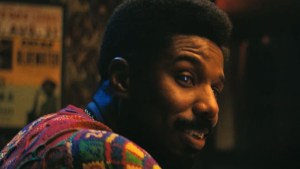Warning: this story contains spoilers for Sunday’s episode of Tales of the Walking Dead, “Blair/Gina.” Déjà vu, time loop, or psychotic disorder? One explains how Circle of Trust Insurance Company co-workers Blair (Parker Posey) and Gina (Jillian Bell) repeat an endless loop on Tales of the Walking Dead. When bossy Blair and meek Gina try to survive the onset of the apocalypse in 2010, they’re stuck reliving a day that ends the same way every time: with Blair and Gina dying over and over. The episode restarts each time their hijacked oil tanker truck explodes, the constant result of Blair and Gina meeting at their nexus point — a gas station on their way out of Atlanta, Georgia. (Read the full episode recap here.)
Videos by ComicBook.com
Folie à deux
The episode begins with receptionist Gina documenting overbearing boss Blair’s suspected personality disorders, including narcissism, sociopathy, bipolar I, bipolar II, and schizophrenia. Gina researches folie à deux, a psychotic disorder in which two closely associated individuals share a similar delusional system.
Directly translating to “folly of two” or “madness shared by two,” folie à deux is referred to as a rare Shared Psychotic Disorder in which there is a transference of delusional ideas and abnormal behavior from one person to another. Reads a portion of Gina’s research: “One person is typically referred to as the primary partner, the principal, or the dominant partner. The secondary partner is typically more submissive. The disorder stems from the primary partner gradually imposing their delusion upon the secondary partner.”
The primary partner typically has some form of major schizophrenia or a major mood disorder like bipolar disorder, the research notes, while the secondary partner is diagnosed with folie à deux.
The Dying Brain
While waiting for an oil tanker to refuel a gas station on their way out of town, Blair reads an article titled “The Dying Brain” to fiancé Brian (Matt Medrano). “At the edge of life and death, a dark wave spreads across the brain,” reads an excerpt from the article about traumatic brain injuries and resulting neurological and psychological damage. Chronic smoker Blair tries to light a cigarette, but Brian stops her with a reminder: no smoking or open flames at gas stations.
The loop begins when the oil tanker explodes and incinerates everyone at the gas station. Blair and Gina reset at Circle of Trust, only to return to the gas station where the situation unfolds differently each time: in one, Department of Homeland Security Agent Leo Rogers (Ameer Baraka) accidentally discharges a gun, hitting the tanker and causing it to explode. In another, Gina steals the truck from the oil tanker driver (Keith Adams), only to die in a fiery crash. In yet another redo, Agent Rogers’ young son, Wendell (William J. Simmons), is in the truck when it becomes a 33-ton runaway bomb on wheels.
Every time Blair or Gina steals the tanker, it blows up. And every time they die, Blair and Gina are the only two who realize they’re trapped in a loop, repeating the event with memories of each death. (As the saying goes: “Insanity is doing the same thing over and over and expecting different results.”)
“Are we dead? Maybe this is a dream,” Blair says, suggesting another possible explanation: morphic resonance.
Morphic Resonance
According to British biologist Rupert Sheldrake, the theory of morphic resonance posits that there’s a “unique ‘morphic field’ containing a collective or pooled memory. So organisms not only share genetic material with others of their species, but are also shaped by a ‘field’ specific to that species.”
In his books A New Science of Life and The Presence of the Past, Sheldrake explains:
Morphic resonance is a process whereby self-organizing systems inherit a memory from previous similar systems. In its most general formulation, morphic resonance means that the so-called laws of nature are more like habits.
The hypothesis of morphic resonance also leads to a radically new interpretation of memory storage in the brain and of biological inheritance. Memory need not be stored in material traces inside brains, which are more like TV receivers than video recorders, tuning into influences from the past. And biological inheritance need not all be coded in the genes, or in epigenetic modifications of the genes; much of it depends on morphic resonance from previous members of the species.
Thus each individual inherits a collective memory from past members of the species, and also contributes to the collective memory, affecting other members of the species in the future.
Breaking the Cycle
It’s only after Blair and Gina begin to work together that the co-workers break the cycle, using their knowledge of the loop to steal the tanker without it exploding. For the first time, they survive the tanker blowing up for the last time.
When Blair asks if they’re dead, Gina answers, “We’re not dead. I think that you have a personality disorder and you passed it to me.” Because people spend more time with their co-workers than their own families, Gina explains, it reasons that they melded disorders.
According to Gina, the “time loop” was her folie à deux: “None of this is real. We ended up at the same gas station, facing the most traumatic of life-altering experiences together. Now we’re sharing a delusion. None of this is real, but the disorder is real.”
Blair asks what it was like that time Gina died, reanimated, and ate her, but it “didn’t happen,” Gina explains. “It isn’t real.”
New episodes of Tales of the Walking Dead premiere Sundays on AMC and AMC+.
Follow @CameronBonomolo and @NewsOfTheDead on Twitter for TWD Universe coverage all season long.









